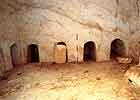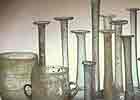Archaeology in Israel: Akeldama
The Akeldama area is situated in one of the most impressive locations in Jerusalem. The rocky cliffs and steep slopes of Mt. Zion, the Valleys of Hinnom and Kidron, and the village of Silwan spreading towards the Mt. of Olives, all lend to the historic and biblical atmosphere of the scene. The dramatic presence of the late 19th century monastery of St. Onuphrius, rising from the head of a cliff, adds its own attractive touch to this delightful corner of Jerusalem.
 Cave 1, Chamber 1, general view of the loculi |
In 1989, the Jerusalem Municipality conducted routine development work in the area. Upon widening a narrow street near one of the approaches to the Silwan village, bulldozers uncovered a number of square openings hewn in the rock. The Israel Antiquities Authority immediately stopped the road construction. After crawling through the narrow openings, the archaeologists found themselves standing inside a large burial complex, which appeared to be intact. Moving carefully from one chamber to the other, their flashlights revealed an abundance of artifacts scattered on the floors: pottery and glass vessels, oil lamps and many ornamented and inscribed ossuaries (stone boxes for collecting bones), all indicating that these caves had not been plundered.
The significance of the findings called for a systematic excavation of the site. The three large caves proved to be part of an extensive Jewish burial ground in use at the end of the Second Temple period, which terminated in the year 70 CE, when Jerusalem was conquered and the Temple destroyed by the Roman Legions. Alongside the original burial phase from the end of the Second Temple period (1st century CE), solid evidence was found of reuse of the tombs for funerary purposes during the Late Roman (2nd~th centuries CE) and Early Byzantine (5th~6th centuries CE) periods. The miraculously undisturbed caves allowed for optimal reconstruction of the burial sequence at the site.
The Akeldama complex includes three separate burial caves, hewn in the Jerusalemite rock. Each cave contained two to three chambers with loculi (burial niches -kokhim), and an inner chamber hewn with arcosolia (arched shelves) and burial troughs. Special chambers served as ossuary repositories. Some of the chambers were closed by decorated stone doors fitted with pivots and hinges.
 Glass Vessels |
The Akeldama excavations revealed some of the finest known examples of tomb architecture and ornamentation. All three burial caves had been meticulously carved in the hard limestone formation, and excel in their precise angles and aesthetic finish. The high quality of execution indicates that these caves served some of the more affluent Jewish families of the city. Among the finds were pottery vessels: bowls, storage jars, and oil lamps, glass vessels and jewelry, as well as 39 complete ossuaries, most of them richly decorated, and inscribed with the names of the deceased in Hebrew and Greek. These unique finds reflect Jewish customs and traditions in Jerusalem on the eve of the destruction of the Temple.
The Akeldama excavations revealed some of the finest known examples of tomb architecture and ornamentation. All three burial caves had been meticulously carved in the hard limestone formation, and excel in their precise angles and aesthetic finish. The high quality of execution indicates that these caves served some of the more affluent Jewish families of the city. Among the finds were pottery vessels: bowls, storage jars, and oil lamps, glass vessels and jewelry, as well as 39 complete ossuaries, most of them richly decorated, and inscribed with the names of the deceased in Hebrew and Greek. These unique finds reflect Jewish customs and traditions in Jerusalem on the eve of the destruction of the Temple.
The Jewish Tomb Owners
Some affinities of these Second Temple period Jerusalemite families may be reconstructed by means of the names inscribed on the ossuaries. Two of the caves were probably owned by Jewish families, both originating from North Syria: one belonged to the Eros family, while the other served the Ariston family, which came from the city of Apamea. It is also possible that the two families were linked by marriage. The cornmon origin of both families from the Syrian diaspora may have been the binding link: families from a common cultural milieu, maintaining close contacts in their new homeland.
The name 'Ariston of Apamea', inscribed on one of the ossuaries, may be identified with a person described in the Mishna as bringing gifts from abroad to the Temple in Jerusalem. It is likely that this ossuary indeed that of the same wealthy Apamean Jew. This is one of very few examples of personalities known from ancient sources and attested in archaeological record.
Sources: Israeli Foreign Ministry


